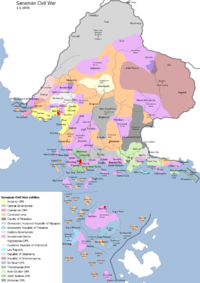Sanaman Civil War
| Sanaman Civil War | ||||||||
|---|---|---|---|---|---|---|---|---|
|
||||||||
| Belligerents | ||||||||
File:Sanama flag1.png Sanaman Federation of People's Republics
| Benacian Republic of Amarr Highpass and Sanilla
|
|||||||
| Commanders and leaders | ||||||||
| Strength | ||||||||
| 550,000 regular forces (V.1698) | 875,000 militia and revolutionary fighters (V.1698) | 175,000 Vanguards | ||||||
| Casualties and losses | ||||||||
| 4 Army soldiers | 56 militia members | 1 dog | ||||||
The Rice Riots of 1697 transitioned into the Sanaman Civil War in Puwha Kawlapali (IV) 1698 following the Malliki Tosha Plaza Massacre and a general breakdown of the government's ability to maintain public order, leading to the national government losing effective control over large parts of the country, leaving large swaths of both urban and rural territory in the hands of various armed militias, most notably those aligned with the Peoples' Front and those aligned with the Democratic Humanist Party.
Background
Events
IV.1698
The Rice Riots transitioned into the civil war in Puwha Kawlapali (IV) 1698, with Peoples' Front and Democratic Humanist Party militias forming and taking over large areas of Sanama, with the stated intent of guaranteeing public safety and order. The dominant party in the PF, the Sanaman Liberation Front (revolutionary) changed name to the Sanamati Democratic Party (Tatawal Koslhen Sharamyaya Sanamati), with "Sanamati" being a neologism meaning "Sanaman person" in the wider sense of a citizen of the Sanaman state. At the same time, the TKSS assumed supreme guidanceship over the Peoples' Front, with the other parties becoming entities within the wider TKSS. The TKSS also established several democratic people's republics across Sanama to organise the struggle against the government and other militias, while providing services and a governing framework for the areas under its control.
The communalist groups formed around the TKSS coalesced into a growing popular movement, where more and more people joined the revolutionary forces. Many sympathisers also engaged in other ways, such as organising citizen's committees, local public safety groups, supply runs, and other kinds of direct and indirect support. The various groups soon consolidated a number of areas under their control. The Cisamarran Democratic People's Republic formed in the west, from Porcavacca on the Napole peninsula all the way up and past Acquecalde, bordering in the east to the Amarran DPR, controlling much of the Amarran coast and large parts of Fatehpur Sikri. In the south and southeast, the Western and Eastern Sanillan DPR's formed with a combined leadership, controlling four separate areas. The western part formed in and around Niyi, the central around Soli and Rhan, the eastern from Pakor City and eastwards, while the fourth area was the entire island of Kayalëkada. Local uprisings in Brightown and New Woodshire in Thanatos quickly formed the Thanatossian DPR, and in Highpass the Highpassian DPR formed centered on Abermeade. The final DPR formed on So Sara and Gehenn after local Yardistani farmers joined the communalist cause against oppressive government and fascism. Simultaneously old civil service cadres, leftover Shirerithian administrative cadres and downsized military personnel joined the Democratic Humanist Party, taking over three smaller pockets in Amarra and Sanilla: one centered on Richmond and Gardenholm, one stretching across central Sanilla and one centered on Pinito City. The most successful Humanist entity was though the Democratic Humanist Republic of Highpass, controlling most of northern, central and western Highpass, owing much of its success to active support from the Benacian Union. The surrender of Rhodondra was a particularly embarrassing debacle for the Sanaman government. In Cisamarra, Thanatos, Z and Thanidor, so-called "Democratic Republics" were also formed. These were however little more than gangs controlled by local strongmen seizing the opportunity when the national government was engaged elsewhere. The democratic republics would prove throughout the war to be havens for drug and arms smuggling and human trafficking.
The Battle of Niyi commenced on 21 Puwha Kawlapali (IV) 1698, when government forces launched an attack targeting the strategically important railway hub in Sanestira, with the intent of cutting of SDPR transports between the north and the south of the SDPR. In response, the SDPR scrambled defences and launched a surprise attack from west of Hala City towards Neliko, with the intent of cutting off supply lines between government-controlled western Niyi and Port Niyi.
